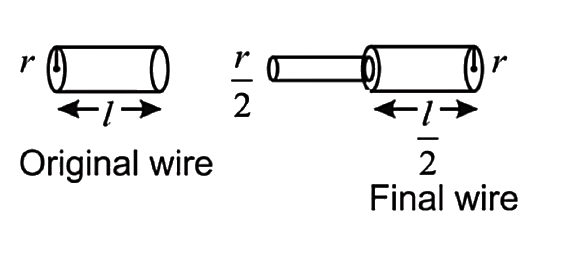A wire of length l is drawn such that its diameter is reduced to half of its original diameler. If the initial resistance of the wire were 10Ω. its resistance would become
40Ω
60Ω
120Ω
160Ω
The correct Answer is:D
To solve the problem step by step, let's analyze the situation given in the question:
Step 1: Understand the relationship between volume, length, and diameter
When a wire is drawn (stretched), its volume remains constant. The volume V of a cylindrical wire is given by the formula:
V=A⋅l
where A is the cross-sectional area and l is the length of the wire.
Step 2: Calculate the initial volume of the wire
The initial diameter of the wire is D. The cross-sectional area A of the wire can be calculated as:
A=πD24
Thus, the initial volume V can be expressed as:
V=A⋅l=πD24⋅l
Step 3: Determine the new dimensions after stretching
After the wire is drawn, its diameter is reduced to half, so the new diameter D′ is:
D′=D2
The new cross-sectional area A′ becomes:
A′=π(D′)24=π(D2)24=πD216
Step 4: Set up the equation for constant volume
Since the volume remains constant, we can equate the initial and final volumes:
πD24⋅l=A′⋅l′
Substituting for A′:
πD24⋅l=πD216⋅l′
Cancelling πD2 from both sides:
l4=l′16
Cross-multiplying gives:
16l=4l′⟹l′=4l
This means the new length of the wire is 4l.
Step 5: Calculate the new resistance
The resistance R of a wire is given by:
R=ρlA
where ρ is the resistivity of the material.
For the initial resistance R:
R=ρlπD24=4ρlπD2
Given that R=10Ω, we can write:
10=4ρlπD2
For the new resistance R′:
R′=ρl′A′=ρ(4l)πD216=64ρlπD2
Step 6: Relate the new resistance to the initial resistance
Now substituting for R:
R′=64⋅4ρlπD2=64⋅(πD24)=64⋅10
Thus:
R′=160Ω
Final Answer
The new resistance of the wire after it has been drawn is:
160Ω
When a wire is drawn (stretched), its volume remains constant. The volume V of a cylindrical wire is given by the formula:
V=A⋅l
where A is the cross-sectional area and l is the length of the wire.
The initial diameter of the wire is D. The cross-sectional area A of the wire can be calculated as:
A=πD24
Thus, the initial volume V can be expressed as:
V=A⋅l=πD24⋅l
After the wire is drawn, its diameter is reduced to half, so the new diameter D′ is:
D′=D2
The new cross-sectional area A′ becomes:
A′=π(D′)24=π(D2)24=πD216
Since the volume remains constant, we can equate the initial and final volumes:
πD24⋅l=A′⋅l′
Substituting for A′:
πD24⋅l=πD216⋅l′
Cancelling πD2 from both sides:
l4=l′16
Cross-multiplying gives:
16l=4l′⟹l′=4l
This means the new length of the wire is 4l.
The resistance R of a wire is given by:
R=ρlA
where ρ is the resistivity of the material.
R=ρlπD24=4ρlπD2
Given that R=10Ω, we can write:
10=4ρlπD2
R′=ρl′A′=ρ(4l)πD216=64ρlπD2
Now substituting for R:
R′=64⋅4ρlπD2=64⋅(πD24)=64⋅10
Thus:
R′=160Ω
The new resistance of the wire after it has been drawn is:
160Ω
Topper's Solved these Questions
- CURRENT AND RESISTANCEBook:RESNICK AND HALLIDAYChapter:CURRENT AND RESISTANCEExercise:Practice Questions (Linked Comprehension)
Explore 5 Videos
- CURRENT AND RESISTANCEBook:RESNICK AND HALLIDAYChapter:CURRENT AND RESISTANCEExercise:Practice Questions (Matrix-Match)
Explore 9 Videos
- CURRENT AND RESISTANCEBook:RESNICK AND HALLIDAYChapter:CURRENT AND RESISTANCEExercise:Problems
Explore 36 Videos
- CIRCULAR MOTIONBook:RESNICK AND HALLIDAYChapter:CIRCULAR MOTIONExercise:CHECK POINTS
Explore 6 Videos
- ELASTICITYBook:RESNICK AND HALLIDAYChapter:ELASTICITYExercise:PRACTICE QUESTIONS (Integer Type)
Explore 3 Videos
Similar Questions
A wire of length l has a resistance R. If half of the length is stretched to make the radius half of its original value, then the final resistance of the wire is

View SolutionA piece of wire of resistance 20Ω is drawn so that its length is increased to twice is original length. Calculate resistance of the wire in the new situation.
View Solution
Knowledge Check
A wire of lenth L is drawn such that its diameter is reduced to half of its original diamter. If the initial resistance of the wire were 10Ω, its new resistance would be
A40ΩB80ΩC120ΩD160ΩA wire of lenth L is drawn such that its diameter is reduced to half of its original diamter. If the initial resistance of the wire were 10Ω, its new resistance would be
A40ΩB80ΩC160ΩD120ΩThe diameter of aluminium wire is reduced to half its original value, then its resistance will become
Afour timesBtwo timesCeight timesDsixteen times
A wire of resistance 18 ohm is drawn until its radius reduce 12th of its original radius then resistance of the wire is
View SolutionA wire of resistance 18 ohm is drawn until its radius reduce 12th of its original radius then resistance of the wire is
View SolutionIf a wire of resistance R is melted and recasted to half of its length, then the new resistance of the wire will be
View SolutionA wire has a resistance of 32Ω. It is melted and drawn into a wire of half of its original length. What is the resistance of the new wire?
View SolutionIf the diameter of a resistance wire is halved, then its resistance becomes:
View Solution